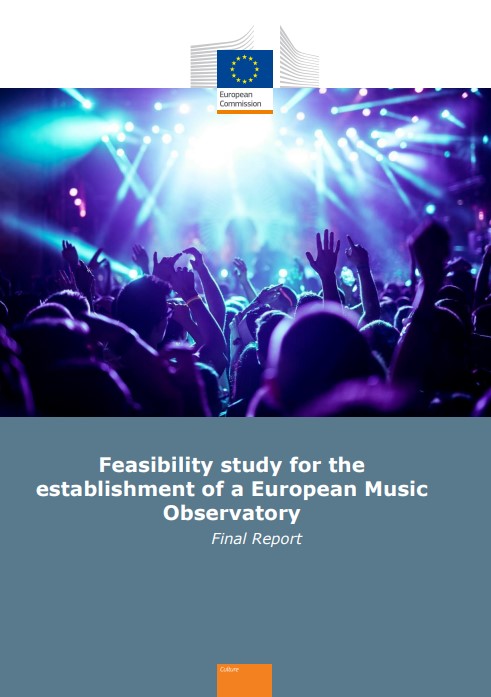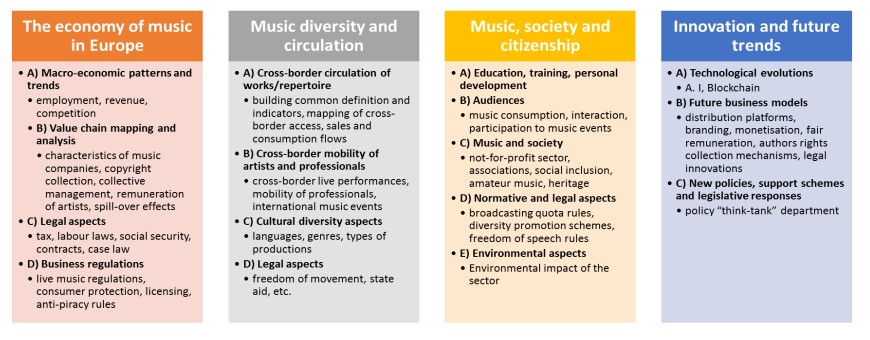Together with 11 other European music organisations, Live DMA is part of the advisory board of the feasibility study investigating a possible future full-scale establishment of a data collection organisation called The Observatory as a core strategic resource to drive relevance and value for future policy actions in the music portfolio and across the sector. This feasibility study in conducted by KEA and Panteia.
The Advisory Board functions as a stakeholder consultation tool, a quality control mechanism and as a tool to support a harmonised approach. Live DMA wants to highlight a few very important points that need more attention :
- The questions of data ownership and data accessibility.
- The practical use to the music sector: what flexibility for the Observatory? How to think the Observatory in a bilateral relationship with the sector, serving its needs?
- What continuity? Will the Observatory work on ‘one-shot’ data collection, or isn’t it a goal to conduct yearly collection to be able to analyse the evolution of the sector.
Data on the music sector is often considered as insufficient, patchy, unreliable or simply non-existent.
In late 2015, the European Commission started a dialogue with representatives from the music sector in Europe with the aim to identify key challenges and possible ways to tackle them, including EU support. “Music Moves Europe” has become the framework for these discussions. As part of the 2018 Preparatory Action “Music Moves Europe: Boosting European music diversity and talent”, the Commission’s EAC Directorate for Culture and Creativity launched four calls in the spring of 2018, among which was “The feasibility study for the establishment of a European Music Observatory (EMO), and a gap analysis of funding needs for the music sector”.
This study investigates the possible development of a future full-scale establishment of a data collection organisation, a European Music Observatory, as a core strategic resource to drive relevance and value for future policy actions in the music portfolio and across the sector.
Live DMA has been involved in data collections for years with The Survey, a shared methodology that produces a set of indicators and reports about live music venues in Europe. Through its experience, Live DMA recommends that the future European Music Observatory should rely on bottom-up organisations and reinforce their representative role such as Live DMA (for the live music sector) as observers and providers of key facts and policy recommendations. A European Music Observatory should be an organisation of collective interest for commercial, not-for profit and public operators active in the field of music; expertise and methodologies should be shared among representative organisations; and the future EMO should give the opportunity to develop transversal studies as well as qualitative studies.
This article presents the Key Findings of the study as well as the overviews of the solutions presented in the study.

Contents of the study:
- Executive summary
- Chapter 1: The need for a European Music Observatory
- Chapter 2: Data needs and gaps
- Chapter 3: Feasible options for the creation of a European Music Observatory
- Chapter 4: Conclusions and recommendations
- Annexes (including a glossary)
Key findings of the study
- Fragmented, scarce and poorly-harmonised nature of the data collection landscape in the field of music;
- Robust and meaningful comparative data collected at a regular basis are essential when it comes to assessing the need for interventions at the EU level to address gaps in the market and enhance the efficiencies and global competitiveness of the sector;
- A European Music Observatory (EMO) would help fill data gaps, contribute to a better knowledge of the sector and help inform music sector policy within Europe.
- Legal basis of the EMO should be as autonomous as possible and the governance model should be as inclusive as possible.
- Best strategy would be a scale-up approach: creating a light initial support structure and increasing the scope of the Observatory over time, allowing it to expand and develop its activities over time. This ‘scale-up’ approach would require a lower amount of budget at the beginning, and taking a hybrid approach that allows for testing several actions in parallel and for refining working methods will allow for development into an eventually more structured approach to an EMO, whilst showing added EU value.
Overviews of the study
Overview of main data needs for the music sector (4 pillars that could be developed for the EMO):

Overview of various options researched for a European Music Observatory:
The chart presenting the various options researched for a EMO can be downloaded at the end of this article.
Overview of possible ‘scale-up’ options for a European Music Observatory
EMO needs a long-term perspective but, right now, need to start on a modest scale, with the view of increasing the scope of the Observatory over a period of time, potentially reaching a fully-fledged independent structure in the future.
There are three potential approaches explored in the context of this study:
- First, to set up an independent body in the same manner as the fully-fledged option that operates on a smaller scale (and reduced budget) to begin with.
- Second, to begin with one of the structures previously identified, such as an in-house or contract management EMO with the view to eventually implementing a fully-fledged option.
- Third, a hybrid approach is proposed, whereby the competent Commission service(s) would initiate a number of parallel actions to gather and improve the European music sector data collection landscape.
